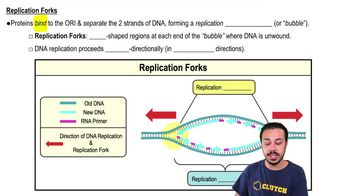Every cell in your body is produced by cell division. Before each cell divides, it must copy its genetic material in a process called D N A replication. Understanding of DNA replication comes largely from studies of E coli, bacteria that are found by the billions in your large intestine. Let's take a look at how D N A replication occurs in an E coli cell. As we zoom in, we see the D N A. At the origin of replication, the two strands of D N A separate, serving as templates for making new strands. The result is a replication bubble. The bubble grows in both directions, forming two replication forks. Let's zoom in on one of them. Many proteins work together at the replication fork. Only some are shown. Here, the D N A is unwound, and D N A polymerases, shown in orange, build new strands of D N A. Original parental D N A strands are shown in dark blue. Newly formed D N A strands are shown in light blue. Because strands in a D N A double helix run in opposite directions, the new strands must be made in different ways. One new strand, the leading strand, is built continuously. The other new strand, the lagging strand, is built in pieces. First, let's focus on the leading strand. D N A polymerase builds a new strand of D N A by adding D N A nucleotides one at a time. Each new nucleotide must pair up with its complementary nucleotide on the parental strand. Adding new nucleotides works the same way on both the leading and lagging strands. Each piece of the lagging strand begins with a short segment of R N A shown in red. A clamp surrounds the R N A and attaches to D N A polymerase, which builds the rest of the new piece as D N A. When the piece is finished, it is released from D N A polymerase. How are pieces of the lagging strand joined together? A different D N A polymerase removes R N A and replaces it with D N A. However, it cannot finish connecting the pieces. An enzyme called D N A ligase joins the pieces together. Growth of the leading and lagging strands continues on both sides of the replication bubble until there are two identical D N A molecules. Although bacteria are very different from humans, the process of D N A replication in bacteria is similar to what happens in your own cells.
Table of contents
- 1. Introduction to Biology2h 40m
- 2. Chemistry3h 40m
- 3. Water1h 26m
- 4. Biomolecules2h 23m
- 5. Cell Components2h 26m
- 6. The Membrane2h 31m
- 7. Energy and Metabolism2h 0m
- 8. Respiration2h 40m
- 9. Photosynthesis2h 49m
- 10. Cell Signaling59m
- 11. Cell Division2h 47m
- 12. Meiosis2h 0m
- 13. Mendelian Genetics4h 41m
- Introduction to Mendel's Experiments7m
- Genotype vs. Phenotype17m
- Punnett Squares13m
- Mendel's Experiments26m
- Mendel's Laws18m
- Monohybrid Crosses16m
- Test Crosses14m
- Dihybrid Crosses20m
- Punnett Square Probability26m
- Incomplete Dominance vs. Codominance20m
- Epistasis7m
- Non-Mendelian Genetics12m
- Pedigrees6m
- Autosomal Inheritance21m
- Sex-Linked Inheritance43m
- X-Inactivation9m
- 14. DNA Synthesis2h 27m
- 15. Gene Expression3h 20m
- 16. Regulation of Expression3h 31m
- Introduction to Regulation of Gene Expression13m
- Prokaryotic Gene Regulation via Operons27m
- The Lac Operon21m
- Glucose's Impact on Lac Operon25m
- The Trp Operon20m
- Review of the Lac Operon & Trp Operon11m
- Introduction to Eukaryotic Gene Regulation9m
- Eukaryotic Chromatin Modifications16m
- Eukaryotic Transcriptional Control22m
- Eukaryotic Post-Transcriptional Regulation28m
- Eukaryotic Post-Translational Regulation13m
- 17. Viruses37m
- 18. Biotechnology2h 58m
- 19. Genomics17m
- 20. Development1h 5m
- 21. Evolution3h 1m
- 22. Evolution of Populations3h 52m
- 23. Speciation1h 37m
- 24. History of Life on Earth2h 6m
- 25. Phylogeny2h 31m
- 26. Prokaryotes4h 59m
- 27. Protists1h 12m
- 28. Plants1h 22m
- 29. Fungi36m
- 30. Overview of Animals34m
- 31. Invertebrates1h 2m
- 32. Vertebrates50m
- 33. Plant Anatomy1h 3m
- 34. Vascular Plant Transport2m
- 35. Soil37m
- 36. Plant Reproduction47m
- 37. Plant Sensation and Response1h 9m
- 38. Animal Form and Function1h 19m
- 39. Digestive System10m
- 40. Circulatory System1h 57m
- 41. Immune System1h 12m
- 42. Osmoregulation and Excretion50m
- 43. Endocrine System4m
- 44. Animal Reproduction2m
- 45. Nervous System55m
- 46. Sensory Systems46m
- 47. Muscle Systems23m
- 48. Ecology3h 11m
- Introduction to Ecology20m
- Biogeography14m
- Earth's Climate Patterns50m
- Introduction to Terrestrial Biomes10m
- Terrestrial Biomes: Near Equator13m
- Terrestrial Biomes: Temperate Regions10m
- Terrestrial Biomes: Northern Regions15m
- Introduction to Aquatic Biomes27m
- Freshwater Aquatic Biomes14m
- Marine Aquatic Biomes13m
- 49. Animal Behavior28m
- 50. Population Ecology3h 41m
- Introduction to Population Ecology28m
- Population Sampling Methods23m
- Life History12m
- Population Demography17m
- Factors Limiting Population Growth14m
- Introduction to Population Growth Models22m
- Linear Population Growth6m
- Exponential Population Growth29m
- Logistic Population Growth32m
- r/K Selection10m
- The Human Population22m
- 51. Community Ecology2h 46m
- Introduction to Community Ecology2m
- Introduction to Community Interactions9m
- Community Interactions: Competition (-/-)38m
- Community Interactions: Exploitation (+/-)23m
- Community Interactions: Mutualism (+/+) & Commensalism (+/0)9m
- Community Structure35m
- Community Dynamics26m
- Geographic Impact on Communities21m
- 52. Ecosystems2h 36m
- 53. Conservation Biology24m
14. DNA Synthesis
Introduction to DNA Replication
Video duration:
3mPlay a video:
Related Videos
Related Practice














